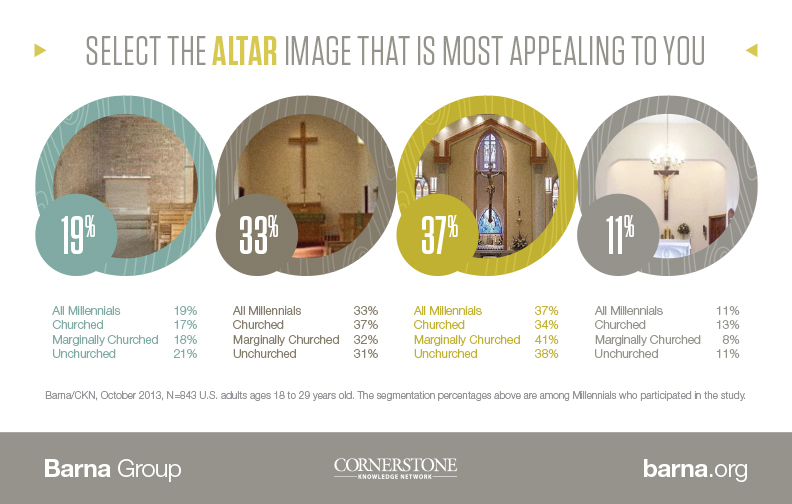
A little over a week ago we were talking about how more and more young Evangelicals prefer to participate in liturgical forms of worship. Now Barna has come out with a new study that tells us what kinds of buildings Millennials prefer to worship in. And there seems to be a definite lean towards more reverent concepts of sacred space than some might expect.
“Many churches today are explicitly constructed not to look and feel too much like a religious place,” Barna notes, “a stark contrast to the ancient cathedrals and churches of old—the very design of which was intended to help people experience the divine. How does this design shift impact worshipers?”
Let’s summarize some of their findings briefly. Most people rejected large auditorium style sanctuaries in favour of smaller sanctuaries. The vast majority prefer altars with large Christian symbols (like a cross or crucifix) as opposed to plain altar pieces. Most prefer stained-glass windows (of varying elaborate natures) to plain-glass.
In the end, the majority described their “ideal” church with these words:
Community (as opposed to Privacy)
Classic (as opposed to Trendy)
Casual (as opposed to Dignified)
Sanctuary (as opposed to Auditorium)
Quiet (as opposed to Loud)
Modern (as opposed to Traditional)
While ‘Sanctuary,’ ‘classic’ and ‘quiet’ are more often associated with traditional church buildings, less than half of survey respondents preferred the word ‘traditional’ over ‘modern,’” Barna explains, noting a bit of a “cognitive dissonance” here among young adults interviewed in the survey. “Many of them aspire to a more traditional church experience, in a beautiful building steeped in history and religious symbolism, but they are more at ease in a modern space that feels more familiar than mysterious.”
Barna’s Clint Jenkins notes that “it’s tempting to oversimplify the relationship between Millennials and sacred space,” as if they were looking only for that which is new and chic. But in reality, “most Millennials don’t look for a church facility that caters to the whims of pop culture. They want a community that calls them to deeper meaning.”
Deeper meaning. That’s what we talked about in our previous post on Evangelicals gone liturgical. “Grandeur hooked me,” Kelsey May explains, “but it wasn’t what made me stay…. The aesthetic of traditional churches appeals to me, but the substance behind it anchors me.”
Let’s make sure we offer that substance in every aspect of our church-life. Be it in liturgy or church architecture, the point is not to provide aesthetic experiences that are beautiful merely for their own sake: they are to draw us into a deeper and richer relationship with the Christ who calls us together.
See Barna’s summary of their sacred space study here.
———————
HT to Gene Veith for bringing this study to my attention.


